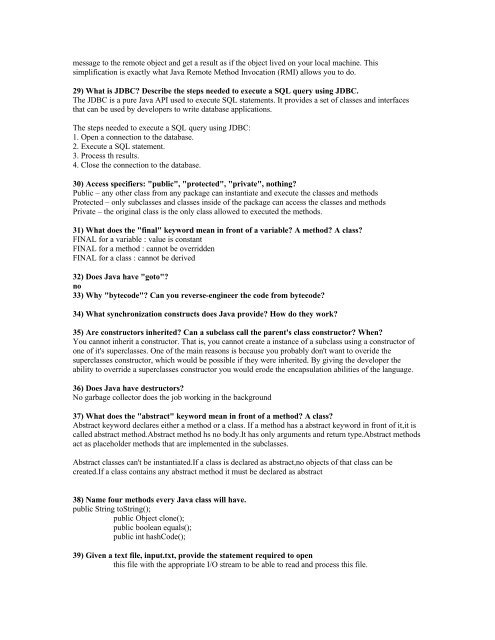Interview Questions in Core Java - Index of
Interview Questions in Core Java - Index of
Interview Questions in Core Java - Index of
You also want an ePaper? Increase the reach of your titles
YUMPU automatically turns print PDFs into web optimized ePapers that Google loves.
message to the remote object and get a result as if the object lived on your local mach<strong>in</strong>e. This<br />
simplification is exactly what <strong>Java</strong> Remote Method Invocation (RMI) allows you to do.<br />
29) What is JDBC? Describe the steps needed to execute a SQL query us<strong>in</strong>g JDBC.<br />
The JDBC is a pure <strong>Java</strong> API used to execute SQL statements. It provides a set <strong>of</strong> classes and <strong>in</strong>terfaces<br />
that can be used by developers to write database applications.<br />
The steps needed to execute a SQL query us<strong>in</strong>g JDBC:<br />
1. Open a connection to the database.<br />
2. Execute a SQL statement.<br />
3. Process th results.<br />
4. Close the connection to the database.<br />
30) Access specifiers: "public", "protected", "private", noth<strong>in</strong>g?<br />
Public – any other class from any package can <strong>in</strong>stantiate and execute the classes and methods<br />
Protected – only subclasses and classes <strong>in</strong>side <strong>of</strong> the package can access the classes and methods<br />
Private – the orig<strong>in</strong>al class is the only class allowed to executed the methods.<br />
31) What does the "f<strong>in</strong>al" keyword mean <strong>in</strong> front <strong>of</strong> a variable? A method? A class?<br />
FINAL for a variable : value is constant<br />
FINAL for a method : cannot be overridden<br />
FINAL for a class : cannot be derived<br />
32) Does <strong>Java</strong> have "goto"?<br />
no<br />
33) Why "bytecode"? Can you reverse-eng<strong>in</strong>eer the code from bytecode?<br />
34) What synchronization constructs does <strong>Java</strong> provide? How do they work?<br />
35) Are constructors <strong>in</strong>herited? Can a subclass call the parent's class constructor? When?<br />
You cannot <strong>in</strong>herit a constructor. That is, you cannot create a <strong>in</strong>stance <strong>of</strong> a subclass us<strong>in</strong>g a constructor <strong>of</strong><br />
one <strong>of</strong> it's superclasses. One <strong>of</strong> the ma<strong>in</strong> reasons is because you probably don't want to overide the<br />
superclasses constructor, which would be possible if they were <strong>in</strong>herited. By giv<strong>in</strong>g the developer the<br />
ability to override a superclasses constructor you would erode the encapsulation abilities <strong>of</strong> the language.<br />
36) Does <strong>Java</strong> have destructors?<br />
No garbage collector does the job work<strong>in</strong>g <strong>in</strong> the background<br />
37) What does the "abstract" keyword mean <strong>in</strong> front <strong>of</strong> a method? A class?<br />
Abstract keyword declares either a method or a class. If a method has a abstract keyword <strong>in</strong> front <strong>of</strong> it,it is<br />
called abstract method.Abstract method hs no body.It has only arguments and return type.Abstract methods<br />
act as placeholder methods that are implemented <strong>in</strong> the subclasses.<br />
Abstract classes can't be <strong>in</strong>stantiated.If a class is declared as abstract,no objects <strong>of</strong> that class can be<br />
created.If a class conta<strong>in</strong>s any abstract method it must be declared as abstract<br />
38) Name four methods every <strong>Java</strong> class will have.<br />
public Str<strong>in</strong>g toStr<strong>in</strong>g();<br />
public Object clone();<br />
public boolean equals();<br />
public <strong>in</strong>t hashCode();<br />
39) Given a text file, <strong>in</strong>put.txt, provide the statement required to open<br />
this file with the appropriate I/O stream to be able to read and process this file.
















